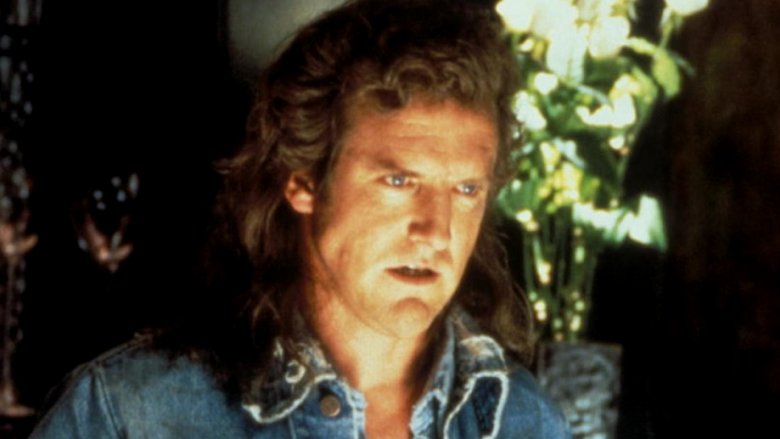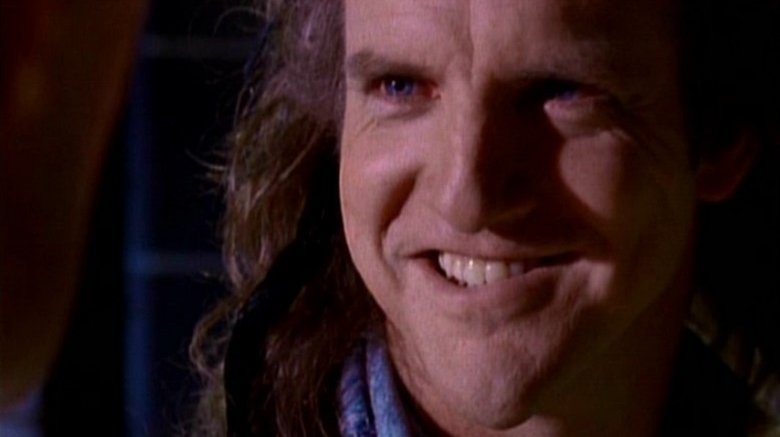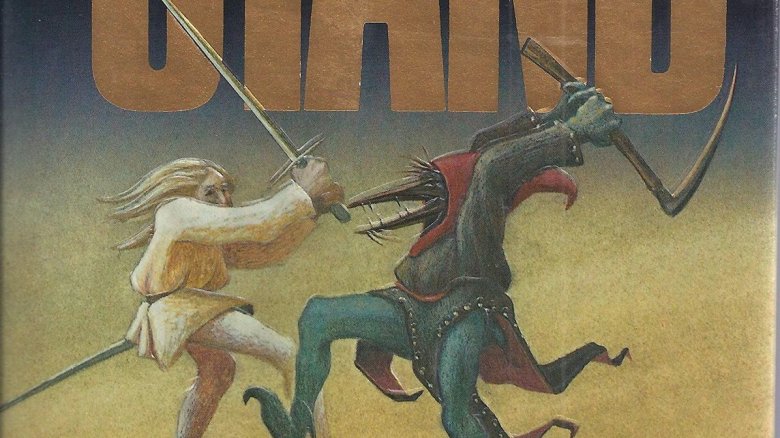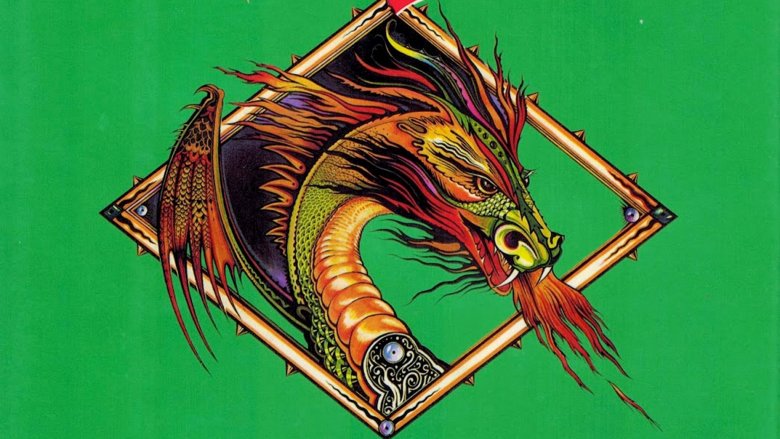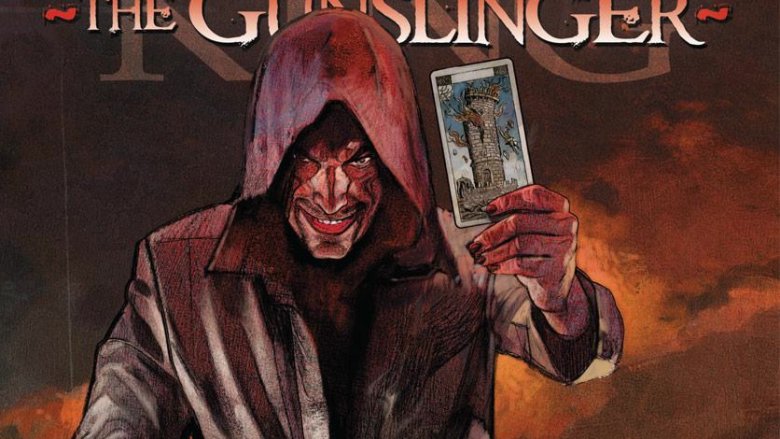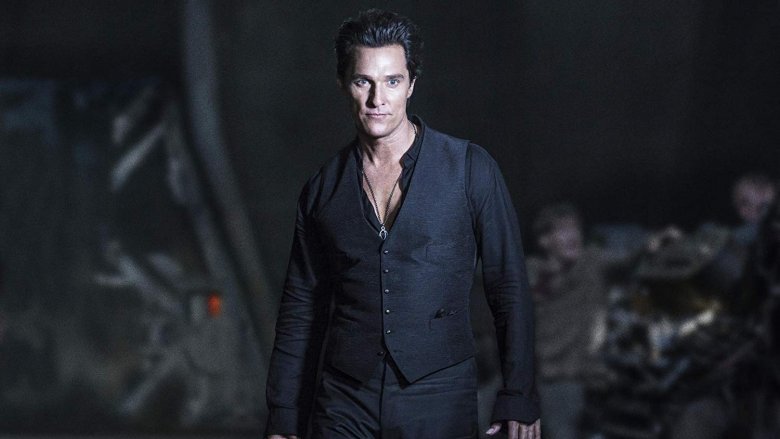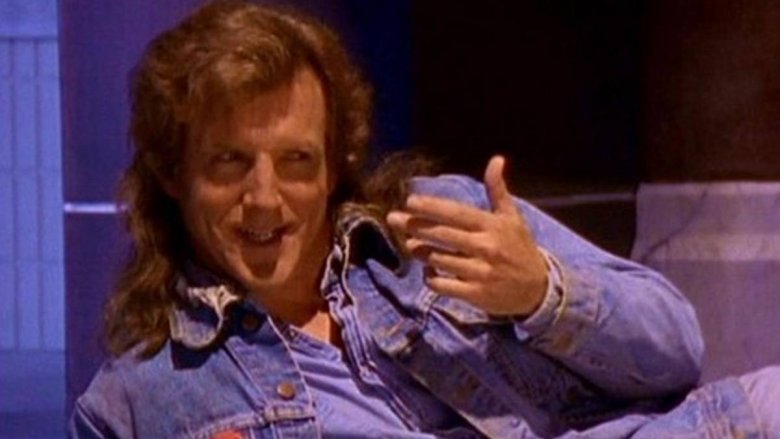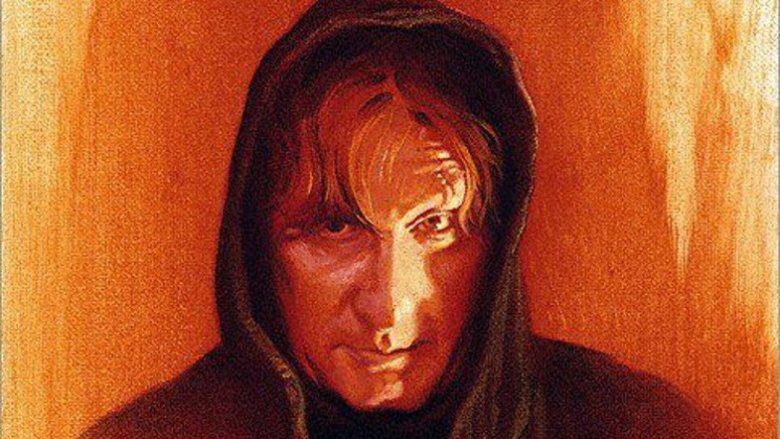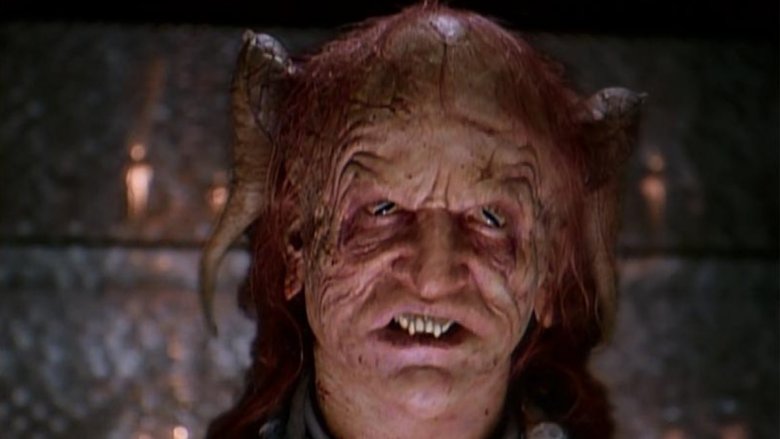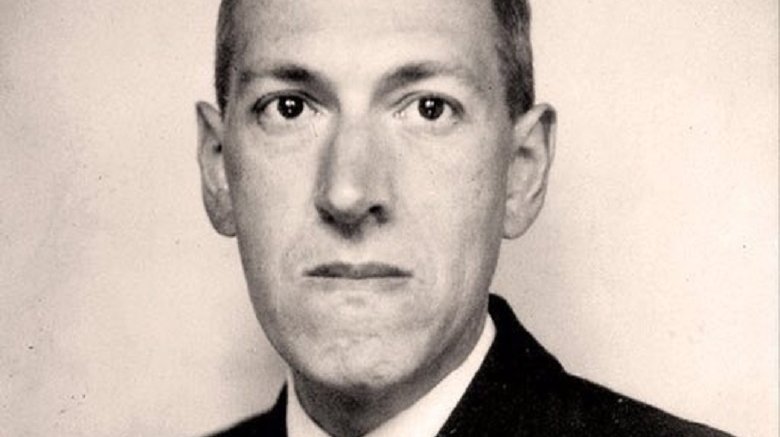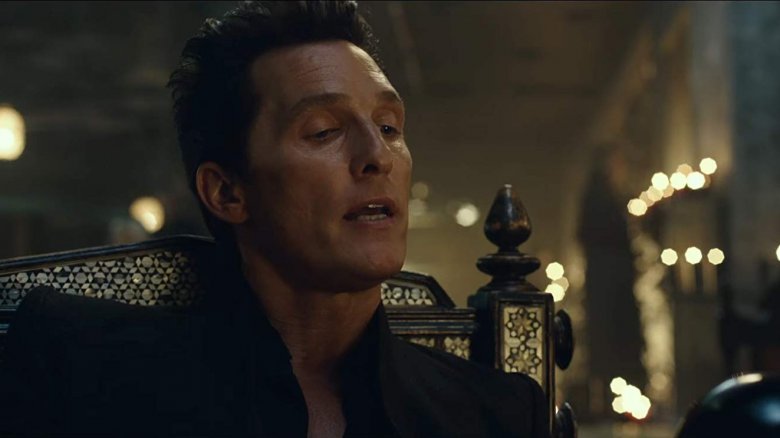The Untold Truth Of Randall Flagg From The Stand
In 1978, Stephen King published The Stand, an epic novel that transported readers into a version of America devastated by a plague. The Stand — both the original (and already long) version and the even longer, "uncut" edition — features dozens of memorable characters, but as with so many of King's works, the villain stands out the most. It was in this ruined, fallen world that King first introduced his readers to Randall Flagg, the "Walkin' Dude" who was the avatar of all things evil in this massive story ... and who turned out to be so much more.
More than four decades after his introduction, Randall Flagg remains in many ways the ultimate Stephen King villain, not just because of his capacity for evil, but because he just keeps popping up in different forms throughout King's multiverse of stories. And while he might not be as famous as Pennywise the Dancing Clown or Jack Torrance, he's just as scary as those two psychos. So make sure you haven't caught a nasty case of Captain Trips, and then we'll take a closer look at King's "Dark Man," Randall Flagg, and his many forms and powers.
Randall Flagg first appeared in The Dark Man
Though he didn't reach readers on a mass scale until the late 1970s, the character we know as Randall Flagg first appeared in the 1960s, when Stephen King was a college student with big literary dreams. One day, while sitting in a restaurant at the University of Maine, King had an image of the man who would become Randall Flagg, and he found it so persistent that he started writing right there.
"It came to me out of nowhere, this guy in cowboy boots who moved around on the roads, mostly hitchhiking at night, always wore jeans and a denim jacket. I wrote this poem, and it was basically just a page long," King recalled. "I was in the college restaurant, only 'restaurant' is too grand a word (it was like a grease pit basically). I wrote the poem on the back of a placemat. It was published, as a matter of fact, but that idea of the guy never left my mind."
The poem, called "The Dark Man," was first published in 1969 and has since been reprinted several times, including an illustrated edition from Cemetery Dance Publications. And it's that little poem that would kick off one of King's greatest villains.
Flagg makes his mark in The Stand
Though he first appeared as only "the Dark Man" in the poem of the same name, Flagg got his proper moniker and a bigger agenda in King's 1978 novel The Stand, which tells the story of humanity's fight for survival in the wake of a catastrophic plague that wipes out 99 percent of the population. In the aftermath of the plague, two dueling avatars of good and evil emerge. On the light side is Mother Abigail, a godly old woman from Nebraska. Flagg — described as a man in jeans, a denim jacket, and boots, who walks the highways of America with his pockets stuffed with pamphlets — is the avatar of the dark.
Flagg sets up shop in Las Vegas, where he builds a force of evil people (or, in some cases, just morally flexible people) to restart civilization in opposition to Mother Abigail's group. Over the course of the novel, it's revealed that Flagg is much more than just a charismatic man, and that he can assume monstrous forms and conjure tremendous energy when needed. At the end of The Stand (spoiler alert), Flagg is defeated when a literal, giant glowing hand — the Hand of God — intervenes and destroys his followers, though Flagg himself is revealed to have survived in an epilogue in The Complete and Uncut Edition of the novel.
Flagg returns in The Eyes of the Dragon
Flagg next appeared in King's 1984 fantasy novel The Eyes of the Dragon, as a court magician who wears a dark hood and is simply named "Flagg." The novel takes place in the kingdom of Delain, a fictional medieval realm later revealed to exist within King's The Dark Tower cosmos, and it tells the story of Flagg's treachery as he attempts to seize power in the kingdom.
To achieve this, he poisons the king of Delain and frames the king's heir, Prince Peter, for the crime, while becoming chief adviser to the new leader, Peter's younger brother Thomas. Flagg spends much of the novel amassing power as the de facto ruler of the kingdom, until Thomas finally confronts and attempts to kill him. Here again, Flagg manifests a demonic form over the course of the story, and he manages to escape despite Thomas' attack. Thomas and his butler, Dennis, eventually find him, but the novel doesn't reveal what happened to Flagg or to the men who sought him, leaving the character alive and free to appear in other stories.
Meet the Man in Black
The Dark Tower is Stephen King's eight-book fantasy saga (seven main series novels and one spin-off novel) that chronicles a lone gunslinger's quest to reach the titular Tower, which is a kind of nexus for all existence. The series begins with the famous line, "The man in black fled across the desert, and the gunslinger followed." Though it's not made clear in the original edition of The Dark Tower: The Gunslinger, later sequels and King's own revised edition of the first book retroactively clarify that the Man in Black is indeed another incarnation of Randall Flagg.
Flagg appears in several different guises throughout the saga, always as a major antagonist of Roland, the gunslinger on the quest for the Tower. He first appears in Roland's life as Marten Broadcloak, a court sorcerer responsible for bringing down the kingdom from the inside and tricking Roland into murdering his own mother, with whom Marten had an affair. Later, he appears as Walter o'Dim, the Man in Black who taunts and tempts Roland with knowledge of the Tower and the future of his quest. He appears again even later in the series as a man calling himself Richard Fannin, and he's also in the spin-off novel, The Wind Through the Keyhole, as the Covenant Man.
Over the course of the seven book main series, it becomes clear that Flagg/Walter's ultimate goal is to ascend to the Tower and rule the multiverse, which sounds pretty evil, if you ask us.
Flagg's background was revealed in The Dark Tower
The Dark Tower series is famous among King superfans not just because of its epic scope, but because its continuity has grown to encapsulate other King stories, either retroactively or deliberately, including IT, Salem's Lot, and Insomnia. This is part of the reason that Flagg is able to appear as a character in so many stories, because he exists as a near-immortal antagonist not just within The Dark Tower, but within the multiverse established for King's fiction.
The seventh book in the main cycle, subtitled simply The Dark Tower, reveals that Flagg was born Walter Padick, a miller's son who set out to find his way in the world and suffered trauma at the hands of a stranger. Rather than returning home, he sought to learn magic, and he eventually mastered many forms of it. This allowed him to catch the eye of the Crimson King, the being at the center of The Dark Tower saga, who brought him into the fold as his servant in the multiverse. Over the course of the series, Walter/Flagg serves both the Crimson King and his own devious ends, and this powerful supernatural presence explains both his seemingly endless life and his ability to appear in several fictional universes at once.
Other appearances in King's stories
Because The Dark Tower presents him as a figure who's extremely difficult to kill and able to traverse the many worlds of the cosmology seemingly at will, Randall Flagg has been freed up by the nature of King's fiction to appear in a number of different tales in a number of different universes, sometimes without any direct confirmation from the author that he's referring to Flagg. For example, the character of Raymond Fiegler in King's collection Hearts in Atlantis is likely another incarnation of Flagg, as evidenced by the R.F. initials. And the same is probably true for the character Richard Farris in the novella Gwendy's Button Box by King and Richard Chizmar.
Though Flagg is his most popular name thanks to his prominence in The Stand, the character is also known to go by many other handles, even beyond his existence as both Marten and Walter in The Dark Tower. Among his other names in The Stand alone are Ramsey Forrest, Richard Fry, and Robert Freemont. This mutability has led King fans to search for him in just about every book the author has ever put out, just in case the villain rears his ugly head somewhere else.
Showing up in The Dark Tower comics
In the 2000s, Marvel Comics began expanding King's Dark Tower lore through a series of comics written by Robin Furth, which shed more light on Walter/Flagg and his origins. Though King's novels name him as the son of a miller, Furth retconned this with King's approval to make the miller Walter's adoptive father. His true father is Maerlyn (The Dark Tower mythology is heavily influenced by Arthurian lore, and Roland himself is a descendant of "Arthur Eld"), who turned him over to a miller so that he could learn to live as a man.
As a teenager, Walter rebelled, burned down his adoptive home, and went out to make his own way as a sorcerer. The comics also revealed that, as Marten, he poisoned Roland's infant brother, one of a number of secret treacheries that would lead the two men to become mortal enemies in King's novels. The mythology established by The Dark Tower comics can at some points create confusion with the mythology set up by the novels, but this can be fixed with the idea that the comics version of Walter may just be another alternate universe incarnation of the character.
The powers of Walter Padick
Because he appears in so many different forms over the course of several different stories, Flagg's overall characterization is somewhat pliable, and King never assigns any specific sense of power level or limitation to the character. This means that he manifests any number of supernatural abilities throughout various stories, all of which make him a dangerous foe.
Stories like The Eyes of the Dragon cast the character as a treacherous sorcerer, skilled in deception, potion-making, and various spellwork. The Stand shows us his tremendous charisma, an ability to convince people to follow him that veers into the supernatural, and a gift for shapeshifting. He's also able to make himself "dim," or hard to see. And at one point in The Dark Tower: The Gunslinger, it's revealed that he can, after a fashion, raise the dead, though they don't necessarily come back whole.
He's also able to commune and bargain with demons, which in The Dark Tower, results in the creation of Mordred Deschain, a monstrous child of Roland, the Crimson King, and a succubus. Though he's apparently able to die, if there's one thing that all his battles have taught us, it's that Flagg is very, very hard to kill.
A connection to Cthulhu
Randall Flagg goes by many names in many stories, but one of the most interesting arrives in The Stand, when various characters who remain on the good side of humanity try to describe him in various ways. One of the heroes, Glen Bateman, gives Flagg the name "Nyarlathotep," and thus grants Flagg implied entry into the pantheon of dark deities that make up H.P. Lovecraft's legendary Cthulhu Mythos.
In the works of Lovecraft, Nyarlathotep originally appears in a poem of the same name, in which he's described as a pharaoh-like figure who travels the world, gathering followers much like Flagg does in The Stand. He also appears as a "Black Man" in Lovecraft's short story "The Dreams in the Witch House" and in the novella The Dream Quest of Unknown Kadath. While many of Lovecraft's other creations within the mythos exist somewhere out in the cosmos, or in some kind of state of hibernation as they await their resurgence, Nyarlathotep is usually depicted as a dark figure wandering the world of men in a human disguise, making him a very Flagg-like figure indeed.
Randall Flagg on the screen
Stephen King's works have been adapted for the screen dozens of times in the more than four decades since his career as a novelist really took off, which means Randall Flagg/Walter Padick has certainly had his share of time on the big and small screens. His most prominent appearance to date is in the 1994 miniseries adaptation of The Stand, directed by Mick Garris, in which Flagg (played by Jamey Sheridan) appears much as he's described in the book.
Flagg made it to the screen again in 2017 — this time in his Walter Padick persona — in the film adaptation of The Dark Tower. In that movie, he was played by Matthew McConaughey, but the screen appearances won't stop there. Flagg is set to appear in the new CBS All Access adaptation of The Stand, in which he'll be played by Alexander Skarsgard, and even more adaptations are already on the horizon. The Eyes of the Dragon is now headed for the small-screen as a Hulu series, meaning Flagg will appear there, and Amazon is at work on their own Dark Tower series, where some version of Marten/Walter will likely appear.
A new future for Randall Flagg
The Stand is a novel that, for all its epic proportions, ends with a certain degree of ambiguity. Yes, there's a final stand in the book between the forces of good and evil, but those who survive it walk away without any clear answers. Among those survivors is Randall Flagg, who in the epilogue to the uncut edition of the novel finds himself on a beach surrounded by a primitive tribe who see him as a kind of God. It could be the perfect setup for a sequel to the book, but Stephen King has resisted any attempt to revisit the story ... until now.
In August 2019, CBS All Access executive Julie McNamara revealed that King has written "a new coda that won't be found in the book" for the final episode of the streamer's upcoming adaptation of The Stand, which is helmed by writer/director Josh Boone. The new ending, described as "a continuation" of the original novel that follows the surviving characters, is of course being kept under wraps, but given that King's epilogue revealed Flagg's survival, it's easy to see how his future could be worked into this new ending.
So, what happens? Will Flagg rise up again with his new tribe of followers and declare a second war on the survivors of the plague? Will he return in a new guise? Will The Stand miniseries itself end up getting a sequel? All of these things seem possible if King is willing to go there.
